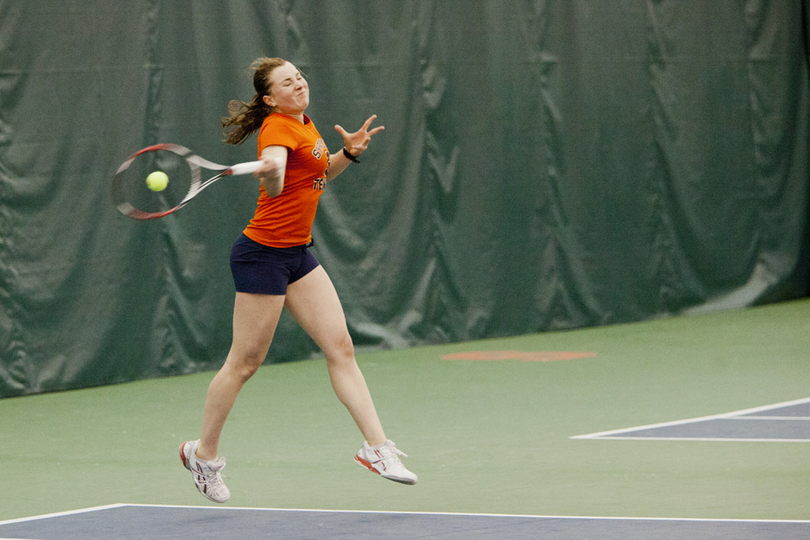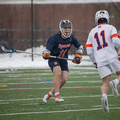Pro pain: Former Syracuse players struggle adjusting to break out professionally

Alessondra Parra, like former teammates Emily Harman and Simone Kalhorn are struggling on the pro singles tour, hovering outside the top 1,000 players in the world. Harman, though, has nearly cracked the top 300 in doubles. Daily Orange File Photo
Emily Harman chases her dream of winning a Grand Slam, and faces the reality of making as little or less than $100 per week. For the 2012 Syracuse graduate, that’s the consequence of a first-round loss on the professional tour.
Ranked outside of the top 1,000 singles players, the prospect of just having enough money to play into the next week can sometimes seem slim.
“If you don’t have the money to somehow figure out a way to get to next week, your dream becomes virtually impossible,” Harman said. “We have to make ends meet somehow.”
Harman is one of three SU graduates currently competing on the professional circuit. The other two, Alessondra Parra and Simone Kalhorn, both played with Harman. Parra graduated last season and helped lead the Orange to a No. 39 ITA ranking. Kalhorn graduated in 2011.
Like almost every athlete who plays tennis at SU, all three joined the program with the hopes of one day competing at the professional level, and even played pro tournaments while at SU. Since head coach Luke Jensen took over as head coach in 2006, he has focused his energy on recruiting American athletes who want to continue their tennis careers after graduating.
Three of Jensen’s graduates currently hold world rankings, according to WTATennis.com. They all play on the ITF, or “Challenger circuit”, as opposed to the WTA circuit. The ITF is generally reserved for players with a lower ranking.
Playing on this circuit has its risks, Harman said. One injury or bad stretch of play can jeopardize a career. Harman experienced a similar fear immediately after graduating, when she suffered a shoulder injury.
“As an athlete, it’s very, very frustrating to be sidelined for anything,” Harman said. “When you know that other players are out there practicing and getting points, moving up in the ranks and making money. It’s really, really tough.”
Harman said that because she attended SU on a scholarship, she can use the money she saved for college to help fuel her tennis career.
Since coming back from her shoulder injury, Harman has encountered the most success of her former teammates. She is No. 311 in the world in doubles, and has moved up very rapidly.
“We’re willing to sacrifice a lot to be out here,” Harman said. “We sacrifice being away from our family and being with our friends. It’s not a glamorous lifestyle. We’re just chasing a dream that we’ve had for a very long time.”
Harman’s ex-teammates lack similar accomplishments.
Parra currently ranks outside of the top 1,000 in both singles and doubles. While she has no plans of quitting the game, she is by no means happy with her performance.
“I don’t think that I’ve had the best results, losing in qualies and not really qualifying for main draws,” Parra said. “I think I have a lot of room to grow, and I’m definitely not satisfied with my results.”
Parra said joining the circuit has made her more conscious of where she’s getting money and how she’s spending it. When she has free time, she makes money by teaching tennis in her hometown of Vienna, Va.
“It can be tight sometimes with expenses,” Parra said. “There’s a lot of managing where money is going and trying to find the best way to do things and cut costs.”
While it hasn’t been smooth sailing for Parra, she said she still loves every experience of playing on the ITF circuit.
The ITF tournaments that take place in the United States are run by the U.S. Tennis Association, and are well organized, Parra said. The majority are played at country clubs and college campuses, and often give $10,000-$50,000 to the winner.
For some of the larger tournaments, the hotels are paid for. But for others, the athletes are in charge of finding their own place to stay.
One way to save money is to stay with a host family, a program that is often coordinated with tournament event staff. Parra said the families usually either love tennis or are just really friendly.
“It’s usually a very good experience as a whole,” Parra said, “not just tennis-wise, but you meet a lot of people, too.”
Parra and her former teammates are familiar with the lifestyle of the Challenger circuit, but both she and Kalhorn played in the WTA Bank of the West Classic last July.
The two played together in the doubles tournament and lost in the first round. While Parra lost in singles qualifying, Kalhorn played the match of her career. She faced off against former Wimbledon semifinalist Mirjana Lucic-Baroni, and took her to three sets before falling. Even with the loss, Kalhorn said that match gave her motivation.
“I feel like when I played my match against Lucic, that was just really reassuring and motivating,” Kalhorn said. “You’re right around the corner from being up there with the top players.”
The mounting first-round losses don’t help cover the cost of travel and housing, but Kalhorn said she’s trying not to focus on the money.
“You’re not really worried about the money right now, you’re chasing the points,” Kalhorn said. “Obviously, it’s an investment. You’re paying to get to the tournament and you’re just planning on doing well.”
Even with all of the risks associated with playing professional tennis, Jensen still builds his program around that ideal. He recruits only Americans in hopes of one day producing one of the country’s next great players.
“In the 80s, that was commonplace,” Jensen said. “The places that I went on my visits, everybody did it, everybody played. And that’s why American tennis was so extraordinary at the professional level. The collegiate ranks, the pathway, was really the breeding ground for the next American talent.”
With Syracuse’s move to the Atlantic Coast Conference, Jensen said he hopes it will bring in better athletes who want to compete at both the highest level collegiately and professionally.
“It’s a huge draw for us,“ Jensen said. “And because our schedule is so strong on the professional side in the fall and the summer, it attracts that kind of kid who needs and wants that kind of competition.”
For now, it’s just this trio that represents the Orange on the pro circuit. All three still keep in touch and rely heavily on the current team and coaches for support.
Parra said even though the Orange often traveled to play in professional events during her time, traveling alone helps her realize she’s in the real world now.
“I’m fortunate enough to have teammates like Simone and Emily on tour,” Parra said, “and I know that I can count on them if I really needed something.
“But it’s not the same. You’re a professional, and this is just what you do.”




